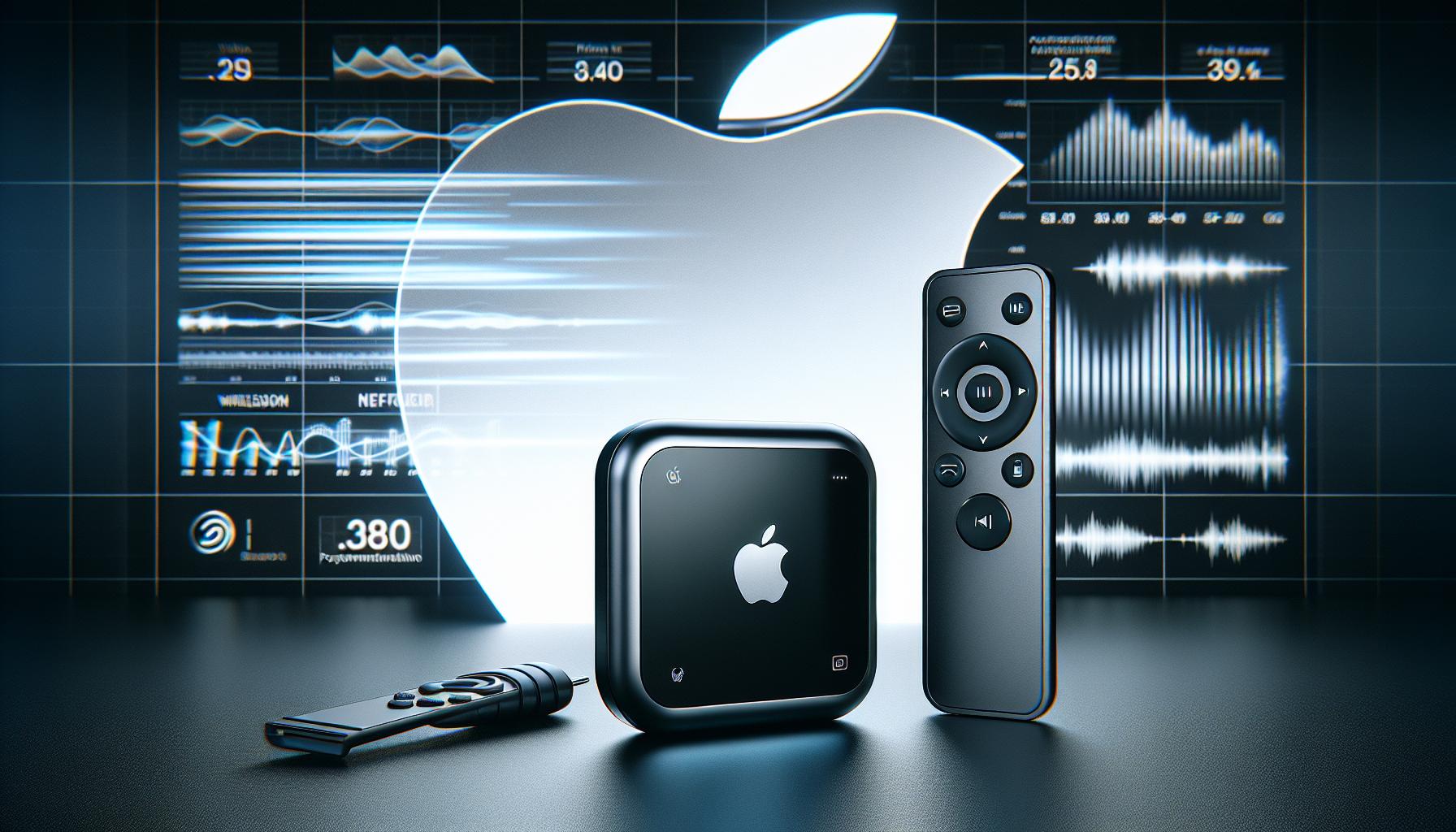Ever find yourself in a pickle with your Apple TV acting up? Don't fret! A simple reboot can often fix many common issues. Whether it's sluggish performance, an app acting glitchy, or just general weirdness, rebooting could be your quick and easy solution.
Why Rebooting Apple TV is Important
Rebooting your Apple TV might seem like a simple step, but there's more than meets the eye. Behind the scenes, it's doing a great deal to keep your streaming experience high-quality and glitch-free.
When your Apple TV is acting up, it's often due to apps behaving oddly, a sluggish interface, or a sudden unexplained error. These can definitely put a damper on your binge-watching plans. The good news? A simple reboot can often fix these issues.
Under the hood, a reboot of your Apple TV is akin to having a restart for your computer. It refreshes the operating system, clears RAM (random access memory), and generally gives your device a fresh start. It's a helpful tool that often resolves those frustrating, intermittent issues such as sluggish performance and glitchy apps.
- Sluggish performance: When your Apple TV is slow or unresponsive, it's akin to being stuck in slow traffic. It's frustrating when you're eager to start a new show or catch up on your favorite series. Rebooting can help by clearing RAM and getting rid of any processes that might be slowing your device down.
- Glitchy apps: Sometimes, apps don't load correctly or behave erratically. This could be due to anything from a bug in the app itself to a simple overload of the system. A reboot gives your Apple TV a fresh start and a chance to reload apps correctly.
- General weirdness: If your Apple TV starts acting unusually, and nothing seems to solve it, a reboot is a good first troubleshooting step. It refreshes everything and can often eliminate those odd, unexplained problems.
Rebooting takes just a few minutes and can be done right from your Apple TV's interface. It's an efficient, effective way to troubleshoot common issues. Now, let's look at the steps on how to reboot your Apple TV.
Different Ways to Reboot Apple TV

There are multiple methods to reboot your Apple TV; let's talk about the two most common and straightforward ways. Keep in mind that each approach serves the same purpose to refresh your device's system and resolve any glitches.
1. Using Apple TV's Interface
Your Apple TV's interface provides the simplest method to reboot. Here's how to do it:
- Go to 'Settings' on your Apple TV home screen.
- Choose 'System' and then select 'Restart.'
Your Apple TV should reboot automatically, eliminating any temporary system hiccups that might have been causing issues.
2. Using the Remote
When your Apple TV isn't responding to commands via the interface, your remote control jumps into the rescue. Here's the step-by-step process:
- Press and hold the 'Menu' and 'TV/Home' buttons simultaneously on your Apple TV remote.
- Release both buttons when you see the Apple logo on your screen.
This method initiates an instant reboot sequence, offering an effective solution when your device's interface is responding sluggishly or not at all.
Also, an unmentioned bonus method includes unplugging your Apple TV from its power source, waiting for a few seconds, and plugging it back in. It's a fast and surefire alternative when all else fails or for non-tech-savvy Apple TV owners, no navigating required!
Method 1: Restart from the Settings Menu

One of the most reliable ways to reboot Apple TV is through the settings menu which is built into the device's user interface. Navigating this menu is fairly intuitive and the steps to restart your Apple TV are straightforward.
Start by powering up your Apple TV. Take your remote control and select "Settings" from the main Apple TV menu. From there, you should see an option that says "System". Go ahead and click on it. In the "System" menu, you'll find an option labeled "Restart". That's exactly what you need. Select the "Restart" option and your Apple TV begins the process of rebooting itself.
Now you might be wondering, "What if my Apple TV is frozen and I can't navigate the menu?" Don't fret - there are alternative ways to reboot your device that don't rely on the user interface. We'll explore these options in detail in the upcoming parts of this article.
The option of restarting from the settings menu is not only intuitive but provides a controlled way to refresh your device's system. It's a simple yet effective method to ensure your device runs smooth as possible avoiding any common glitches.
Remember, as a word of caution, restarting your device frequently might cause unwanted wear and tear on your Apple TV. So, its advisable to use this method when it’s really necessary and not just at the drop of a hat.
Remember, your Apple TV is a sophisticated piece of technology. It's designed to work efficiently and effectively but like all tech devices, occasional issues are inherent. So, don't let a frozen screen or minor glitch discourage you. With these handy reboot methods, you'll have your Apple TV back up and running in no time.
Method 2: Use the Siri Remote

Are you stuck with a glitchy Apple TV, and the settings menu isn't working for you? Fret not, your Siri Remote could be your savior here. The Apple TV remote can act as a direct gateway to restart your device. Sounds too simple? That's because it is.
Make sure your Siri Remote is charged up, then follow these easy steps:
- Press and hold the Menu and Home buttons simultaneously
- Continue to hold these buttons for about ten seconds
- Release them after you see the Apple TV light flash on your device
This method involuntarily emulates a soft reset and can clear up minor issues efficiently. However, it's crucial to note, this may not fix serious software hiccups on your Apple TV.
Interestingly, you might find yourself in a situation where you can't track down your Siri Remote. Or perhaps, you might've misplaced it, or it's out of charge. Panic not, Apple's got you covered even in those scenarios. There's an alternative way to reboot your Apple TV without using the Siri Remote. You can use Apple's Remote app to restart your device. This app can be handy and eliminates the dependency on the physical remote.
The following steps outline how to reboot your Apple TV using the Apple Remote App:
- Make sure your iOS device and Apple TV are connected to the same network
- Open the Remote app on your device
- Tap on the Apple TV icon
- In the upper right corner, tap the control center icon
- Finally, tap "Restart"
Isn't that fairly straightforward and easy? So remember, if you're encountering issues with your Apple TV, your trusty Siri Remote or even your everyday iPhone can come to the rescue.
Method 3: Unplug and Replug the Power Cable
Sometimes, the solution to your problem lies in good old fashioned manual restart techniques - like unplugging and replugging the power cable. It's a method as old as time but just as effective. The process is straightforward - here's how to do it.
First, navigate to where your Apple TV is stationed. Look for the power cord that connects the device to the electric outlet. This is what provides the energy to function and it's the fundamental piece of the puzzle in this method.
Proceed by securely holding the plug, not the cable, and gently pulling it from the electric outlet. This action powers off your Apple TV completely, hence dismissing any ongoing processes your device might be running.
You might be tempted to plug the power cable back in immediately but resist the urge. Instead, wait for a few seconds, even a minute if you can spare it. This small pause is critical as it ensures that any residual power is drained from your Apple TV. Only after this should you go ahead and plug the power cable back into your electric outlet.
Upon replugging, your Apple TV starts the boot-up sequence. Note that it might take longer than you're accustomed to due to the complete power cycle it has undergone. This form of restart is called a hard reboot for a reason. It's a profound system refresh that can solve significant software problems and glitches.
Surely, there are times when your Apple TV continues to misbehave even after trying the interface, remote, and unplug-replug methods. In these stubborn scenarios, you might need to leverage alternative restart options, which we are going to discuss next. However, always remember that every restart method should be used wisely to prevent unnecessary wear and tear on your device.
Tips for a Successful Reboot
Rebooting your Apple TV is as simple as pressing a few buttons or navigating through a few menus. However, some techniques can ensure this process is smooth and successful.
First and foremost, ensure your device's power connection is stable. This might sound overly obvious, but unexpected power interruptions during reboot may cause system instability or even data loss. Make sure your Apple TV is plugged into a reliable power source before starting the reboot process.
Secondly, always turn off any paired Bluetooth devices before starting a reboot. Bluetooth devices can sometimes interfere with a successful reboot, especially if they're actively connected and transmitting data during the process.
In addition, it's good practice to close all open apps before proceeding with a reboot. Apps running in the background can sometimes hinder the reboot process. Your Apple TV has a built-in multitasking feature that lets you do this. Simply double press the TV button on your Siri Remote, then swipe up on each open app to close it.
When using the Apple Remote App, please note that it requires a Wi-Fi network to work. Ensure that your iPhone, iPad, or iPod touch, which is hosting the remote app, is connected to the same Wi-Fi network as your Apple TV.
Remember, while using the hard reboot method of unplugging and replugging the power cable, make sure you to wait for about 10 seconds before plugging the power cable back in. This interval is crucial as it allows initialization of all system components and ensures any temporary data stored in your Apple TV's RAM is wiped out. Double-check that the power cord is firmly plugged in at both ends to prevent any potential disruption.
Lastly, always ensure your Apple TV firmware is updated. Keeping your firmware updated can help reduce the need for frequent reboots and ensure that your device runs smoothly. To check for updates, head to the settings menu, then "System", followed by "Software updates".
Sticking to these tips and guidelines will not only guarantee a successful reboot but will also significantly minimize future technical issues.
Common Issues Fixed by Rebooting Apple TV

Rebooting your Apple TV can solve a multitude of technical glitches you may face while using your device. It's an essential troubleshooting step that has been proven to correct several common issues. Those causing you a headache may include:
- Unstable or poor Wi-Fi connection
- Apple TV not responding to remote commands
- Poor performance or slow operation
- Apps not launching or crashing
- Sound problems
- Image problems
When an excellent Wi-Fi connection becomes unstable or continually drops out, it's frustrating. Losing connection in the middle of your favorite movie or TV show is particularly disappointing. Even though your Internet connection might seem healthy, it's not unusual for the Apple TV to experience connectivity problems. A reboot can often fix these issues by refreshing the connection between your device and the network.
Experiencing responsiveness issues with your remote can also ruin your viewing experience quickly. These difficulties could range from the Siri Remote not controlling the Apple TV to the device not responding to direct commands. A quick reboot can refresh the Apple TV's remote receiver and resolve these frustrations.
Slow operation and crashing apps can see your screen freezing or buffering more often than it should. A performance slowdown isn't something you should have to deal with when you're trying to relax. Clearing the device's temporary memory with a reboot can alleviate these maddening little glitches.
Lastly, sound and image problems can make your viewing experience quite unpleasant. There could be intermittent sound, distortions, or you might encounter a blank screen. While many reasons can cause these, you shouldn't discount a simple reboot of your Apple TV as a possible fix.
However, it's crucial to remember that a reboot isn't a cure-all strategy. It won't resolve underlying issues such as hardware faults or severe software bugs. If you've rebooted your Apple TV and are still experiencing issues, it might be worthwhile seeking help from the Apple Support Center.
Conclusion
So you've learned how rebooting your Apple TV can be a handy fix for common glitches. It's a simple process that can refresh connections, improve remote response, clear temporary memory, and potentially solve sound and image issues. Remember, rebooting isn't a cure-all solution. If you're still experiencing problems, it might be time to reach out to the Apple Support Center. They're equipped to handle more complex issues that a simple reboot can't fix. Don't let technical difficulties stand in the way of your entertainment. Now, you're more prepared to handle these issues head-on and get back to enjoying your Apple TV in no time.
Frequently Asked Questions
Q1: Why should I reboot my Apple TV?
Rebooting your Apple TV can potentially fix a variety of common technical issues including unstable Wi-Fi connections, unresponsive remote commands, app crashes, and audio or visual problems. It clears temporary memory and can refresh device connections.
Q2: Can rebooting fix all issues with my Apple TV?
No, rebooting may not fix all problems. If the issues stem from underlying hardware or software faults, a simple reboot might not resolve them. In such cases, it's wise to seek assistance from the Apple Support Center.
Q3: What are common problems that can be fixed by rebooting my Apple TV?
Rebooting can fix a myriad of issues like unstable Wi-Fi, poor performance, crashing apps, sound and image problems, and lags in response to remote commands. It basically clears the temporary memory, thereby improving the performance of your device.
Q4: Will I lose any data when I reboot my Apple TV?
No, rebooting your Apple TV is a safe process that does not typically result in data loss. It is, however, always a good idea to back up any important data before attempting any kind of system reboot.
Q5: How often should I reboot my Apple TV?
There's no specific rule, but regularly rebooting your Apple TV can help maintain its performance. Conduct rebooting when you notice persistent unresolved issues. But remember, persistent issues may indicate a more serious problem - consider reaching out to Apple Support in such cases.




